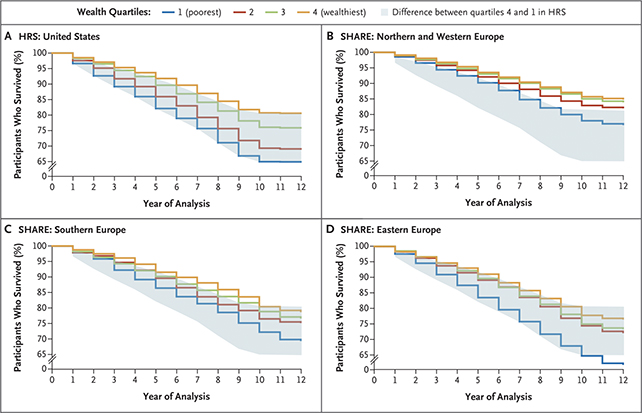New research shows a significant gap in mortality rates between the US and Europe, with even the wealthiest Americans more likely to meet an early death than the wealthiest Europeans – and in some cases, more likely than the poorest in some European countries too.
While having more money was unsurprisingly associated with lower mortality risk (and therefore longer life) in both the US and Europe, according to the stats, the disparity in survival rates between the richest and poorest populations was much stronger in the US.
These results could be explained by Europeans having greater access to healthcare and social welfare, and having stronger social structures than those in the United States, according to the international team of researchers behind the study.

"The findings are a stark reminder that even the wealthiest Americans are not shielded from the systemic issues in the US contributing to lower life expectancy, such as economic inequality or risk factors like stress, diet or environmental hazards," says health economist Irene Papanicolas, from Brown University in Rhode Island.
The researchers crunched the numbers on health and retirement records for 73,838 adults, aged between 50 and 85, across the years 2010 to 2022. For both the US and Europe, the participants were split into four groups (quartiles), from the most to the least wealthy.
The team looked at the chances of each group dying over the study period, which gives us a strong indication of the health and life expectancy of the participants. For each quartile, matching the US against Europe, Americans fared worse.
Mortality rates varied across European regions, but in Germany, France, and the Netherlands, even the poorest groups were shown to be doing better than the richest Americans in terms of how many people died during the study period.
Overall, across both regions, the wealthiest individuals were 40 percent less likely to die than the poorest. For all four wealth quartiles combined, rates of death were 40 percent lower in northern and western Europe than in the US.
"We found that where you stand in your country's wealth distribution matters for your longevity, and where you stand in your country compared to where others stand in theirs matters, too," says health economist Sara Machado, from Brown University.
"Fixing health outcomes is not just a challenge for the most vulnerable – even those in the top quartile of wealth are affected."
The benefits that wealth has on health are well documented – a higher income gives you access to everything from better food to better living conditions to better healthcare – but these findings show the disparities between regions as well as between income levels.
"If we want to improve health in the US, we need to better understand the underlying factors that contribute to these differences – particularly amongst similar socioeconomic groups – and why they translate to different health outcomes across nations," says Papanicolas.
The research has been published in the New England Journal of Medicine.
